Wound Care Biologics Market Size
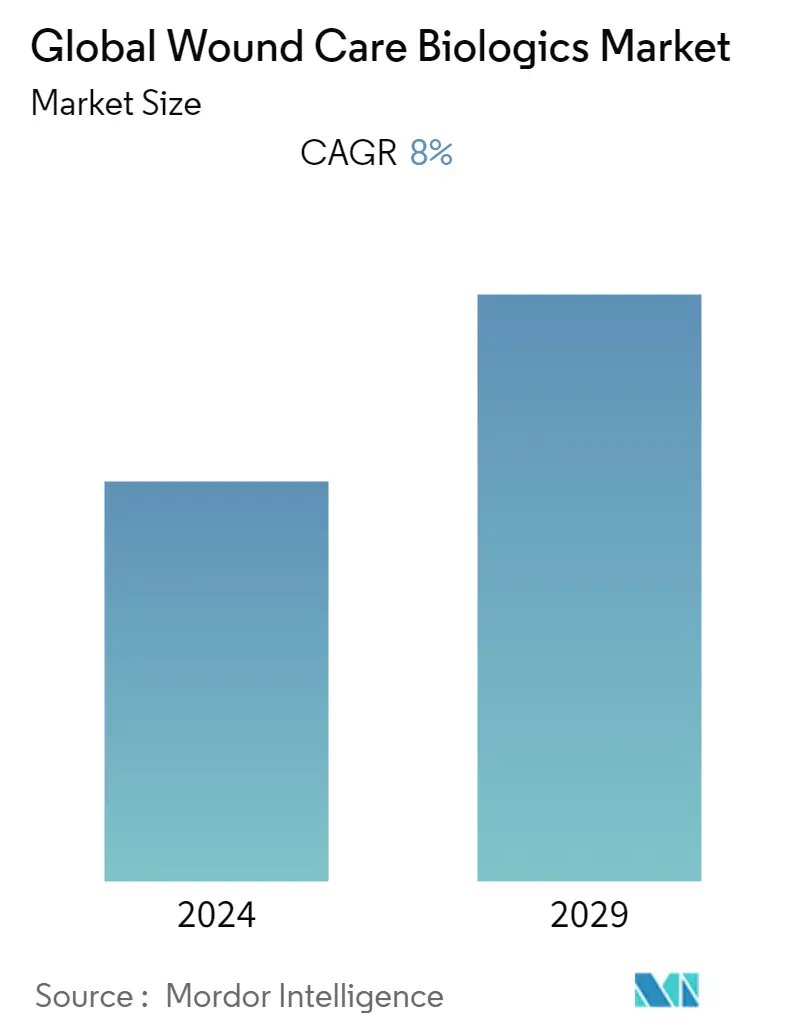
| Study Period | 2019 - 2029 |
| Base Year For Estimation | 2023 |
| CAGR | 8.00 % |
| Fastest Growing Market | Asia-Pacific |
| Largest Market | North America |
| Market Concentration | Low |
Major Players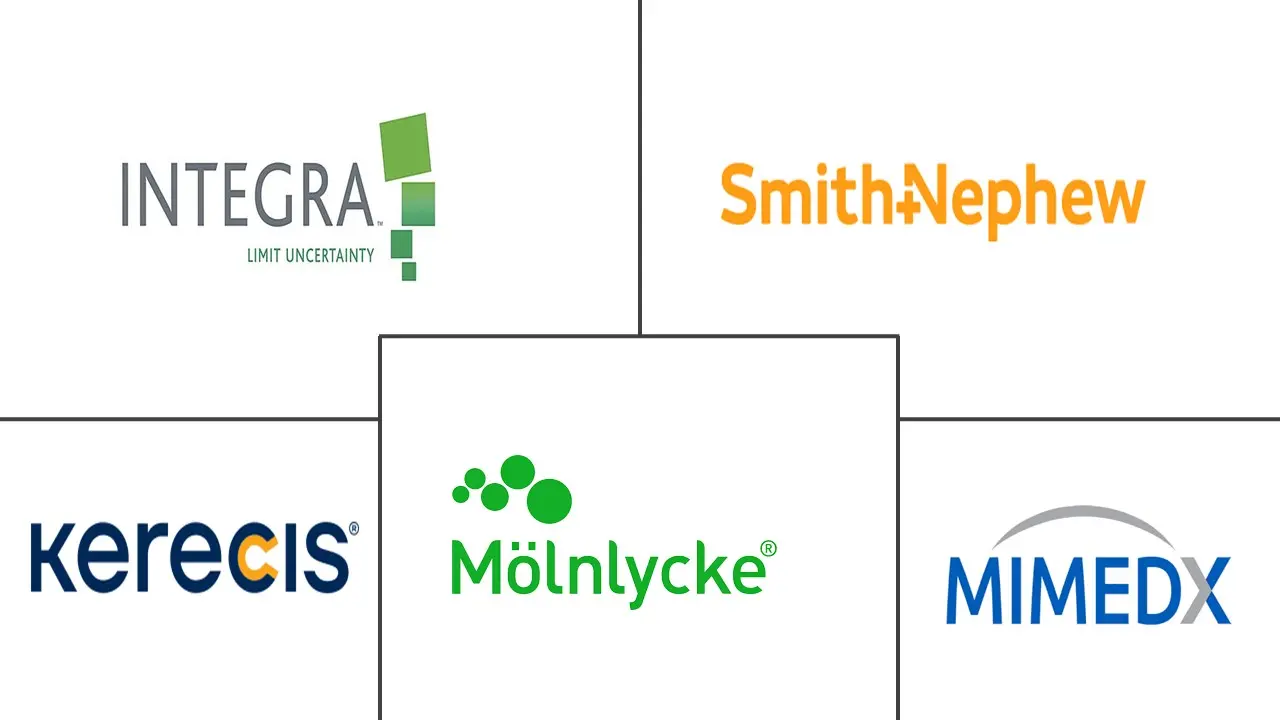
*Disclaimer: Major Players sorted in no particular order |
Wound Care Biologics Market Analysis
The Wound Care Biologics market is projected to register a CAGR of 8% during the forecast period (2022 - 2027).
The COVID-19 pandemic caused serious issues with the provision of wound care. Due to several comorbidities, wound patients are more likely to experience COVID-19's most serious effects. As a result, fewer hospital admissions and reduced diagnoses affect the biologics used in wound care. Even during the COVID-19 crisis, managing chronic wounds is important. According to the study titled 'COVID-19: Issues related to wound care and telehealth management' by Alisha Oropallo, in June 2022, to lower their risk of contracting SARS-CoV-2, patients must make fewer trips to clinics, home health nursing services, or wound care facilities. After a thorough investigation, 115 clinics contained 39,750 wounds involving 17,849 patients. Because of this, the market cannot grow due to a decline in patient visits and wound complaints. Furthermore, as per the study article "The risk of pressure ulcers in a prone COVID population" published in 2021, the study stated that around 88.7% developed anterior pressure ulcers. As per the same source mentioned above the risk of pressure, and ulcers is high in the COVID population. Thus, during COVID-19 the wound care biologics market significantly impacted.
Wound care biologics is gaining popularity for the treatment of wounds and burn injuries. Factors, such as the growing burden of burn injuries, the increasing burden of diabetic foot ulcers and pressure ulcers, and government initiatives regarding wound care treatment are driving the growth of the wound care biologics market.
The wound care biologics market is expected to gain significant traction, with rising in the global prevalence of diabetes, as diabetic patients are prone to developing diabetic ulcers. For instance, the incidence of diabetes among all ages is increasing, mainly due to obesity, unhealthy diet, and physical inactivity. According to the study titled "Diabetic Foot Ulcer" published in the National Library of Medicine in May 2022, worldwide, there are 9.1 to 26.1 million diabetic foot ulcers every year. Approximately 15% to 25% of people with diabetes mellitus have experienced a diabetic foot ulcer at some point in their lives. The incidence of diabetic foot ulcers is destined to rise as the number of people newly diagnosed with diabetes rises each year. As a result, it is predicted that throughout the forecast period, demand for wound care biologics will increase, supporting market expansion. Moreover, burns not only have a high economic impact but also have disastrous effects on the victim's skin. Therefore, the availability of superior quality synthetic substitutes and their growing demand in the treatment of burns have proven beneficial for the industry's growth. According to the study titled "Socio-demographic features and quality of life post burn injury' published in the Journal of Family Medicine and Primary Care in March 2022, there are 6 to 7 million burn injury victims worldwide and in India. One million of them are of a moderate-to-severe grade and require long-term rehabilitation services in addition to excellent medical care. 1.4 lakh near-fatal cases of burn-related accidents occur each year in Delhi alone. Within the last five years, there has been a 10-fold increase in outpatient care and a four- to five-fold increase in hospital admissions due to the increase in burn cases and patients seeking medical attention.
Moreover, market players are frequently launching new products and adopting various growth strategies in their respective segments, which is likely to drive market growth. For Instance, in October 2021, RedDress entered into a partnership with MediGroup to deliver its innovative wound care solution, ActiGraftsystem to MediGroup'smembers. ActiGraftaims to deliver an affordable and efficacious wound solution to MediGroup'smembers to help improve the health and lives of patients living with chronic, non-healing wounds including diabetic foot ulcers, pressure injuries, venous ulcers, traumatic wounds, and post-surgical wounds. Therefore, the growing focus on the development of better treatment options, along with the huge burden of diseases, is expected to drive the wound care biologics market. However, the high treatment cost is expected to restrain the growth of the global market in the forecast period.
Wound Care Biologics Market Trends
This section covers the major market trends shaping the Wound Care Biologics Market according to our research experts:
The Biological Skin Substitutes Segment is Expected to Witness Better Growth Over the Forecast Period
The biological skin substitutes segment is expected to witness better growth due to their wide usage in the treatment of chronic wounds. These skin substitutes have an intact extracellular matrix for structural support. According to the study titled "The Role of Advanced Biologics (Skin Substitutes) in Wound Healing" published in The Wound docs in December 2021, biological skin substitutes which are reasonably priced and easy to come by also permit significant re-epithelialization. Allografts from cadavers, amnion, and porcine skin xenografts are some of the most frequently used biological skin substitutes.
Biological skin substitutes are majorly recommended for burn injuries and injury from road accidents and for treatment of chronic wounds, such as diabetic foot ulcers and venous leg ulcers. According to the study titled 'Editorial: Understanding Diabetic Foot Disease: Current Status and Emerging Treatment Approaches' published in the Frontier in Endocrinology in September 2021, the annual incidence of diabetic foot ulceration is 2.2%, and the lifetime risk of foot ulceration among diabetics is up to 34 %. Within a year, the recurrence rate of diabetic foot ulcers (DFU) can reach up to 40%. 50-60% of foot ulcer patients survive five years after their initial presentation. Chronic wounds lead to complications, such as infection, ulceration, and insufficient blood supply.
Furthermore, new product launches will also favor the overall segment growth over the forecast period. For Instance, in February 2020, Integra LifeSciences has unveiled the Amnio Excel Plus Placental Allograft Membrane. It is their most recent offering in terms of wound care, and it supports soft tissue repair. Additionally, in July 2022, StimLabs, LLC one of the leader in regenerative technologies and products that are revolutionizing patient care through innovation and personalized solutions, has launched a new placental membrane-based product, Enverse used for acute and chronic wound.
Hence, the increasing burden of diabetes and the growing adoption of these products are the major factors propelling the growth of the wound care biologics market.
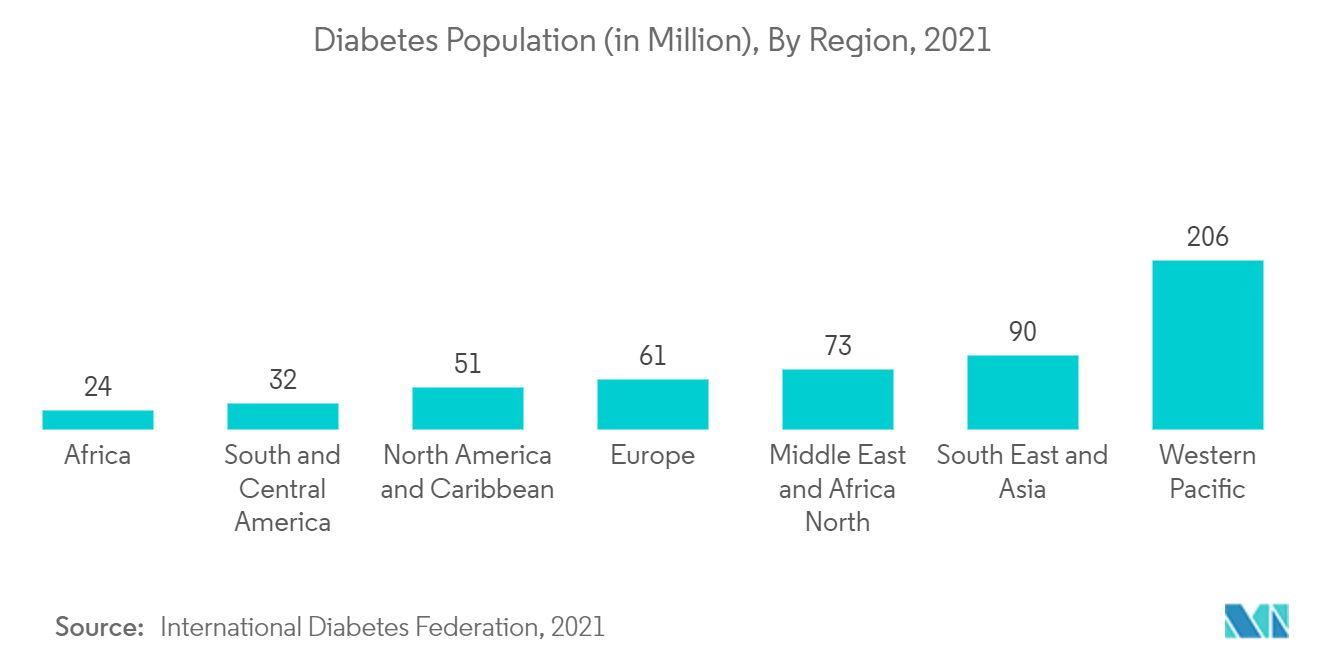
North America Dominates the Wound Care Biologics Market
North America is expected to dominate the wound care biologics market during the forecast years. This is mainly attributed to the growing diabetic population and the rising number of burn injury cases in the region. Furthermore, the growing prevalence of several lifestyle disorders leading to chronic wounds, such as diabetic foot ulcers, venous leg ulcers, and pressure ulcers is one of the key factors estimated to encourage the growth of the advanced wound care management market in the coming years. According to Mission Regional Medical Center in May 2021, more than 29 million people have diabetes in the United States and almost 2 million of those people annually will develop a diabetic foot ulcer or another non-healing wound. Moreover, according to the Center for Disease Control and Prevention Updates in January 2022, 1 in 10 Americans, or 37.3 million people, have diabetes. more than one in three American adults (96 million) have prediabetes. As a result, the rising incidence of diabetes, which is a major risk factor for the development of foot ulcers, and the rising prevalence of diabetes foot in the United States are anticipated to fuel demand for wound care biologics and accelerate the growth of the market during the forecast period.
Additionally, market participants frequently introduce new products and use a variety of growth tactics in their particular segments, which is likely to spur market expansion. For Instance, In March 2022, WoundGenex formed a strategic partnership with MiMedx Group, Inc., a transformational placental biologics company, to launch an exclusive version of WoundGenex's Premier Graft Program for its clients across the country, providing clinicians access to industry-leading allograft products through a convenient purchasing option. additionally, in February 2022, Amniotic tissue allografts provider Amnio Technology expanded its PalinGen membrane product portfolio with the introduction of two new products.
Hence, increased awareness, rapid adoption of new technologies, and increasing chronic wound cases are expected to positively impact market growth in this region.
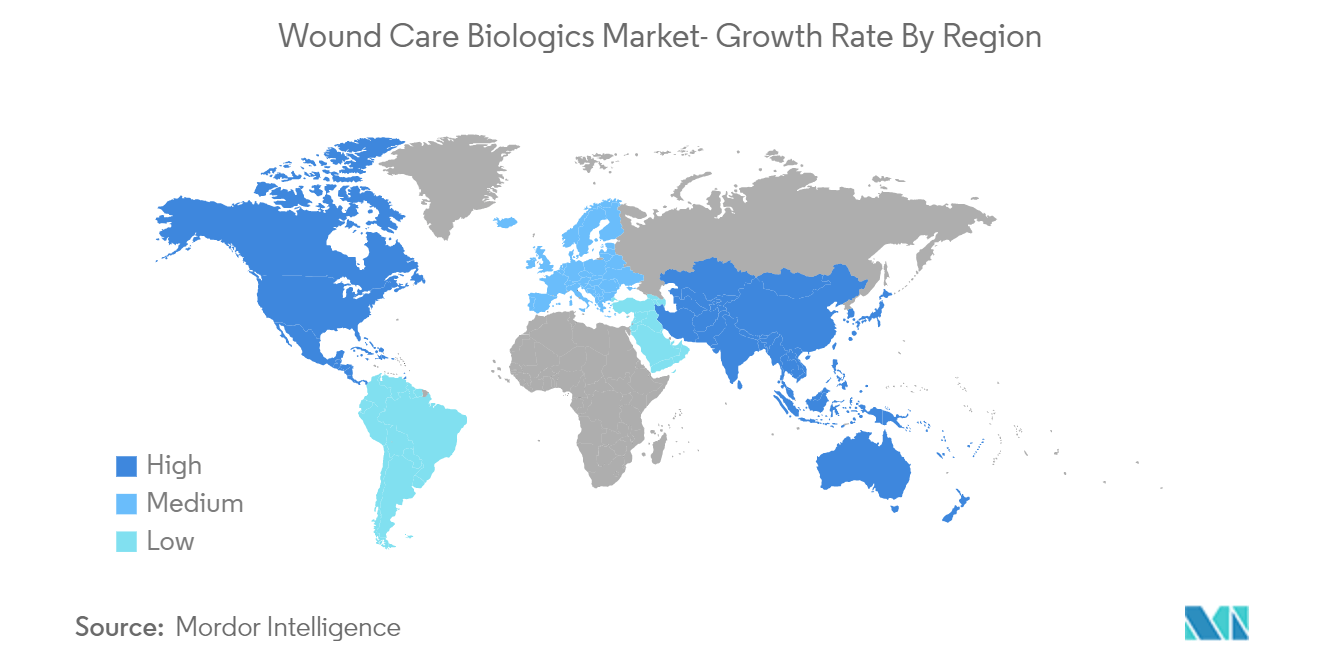
Wound Care Biologics Industry Overview
The wound care biologics market is competitive and many of the global players are in the market. For instance, ACell Inc., Integra LifeSciences Corporation, Kerecis, Marine Polymer Technologies Inc., MiMedx Inc., Misonix, Inc., Mölnlycke Health Care, Smith & Nephew PLC, and Wright Medical Group NV are providing these products across the world.
Wound Care Biologics Market Leaders
-
Integra LifeSciences Corporation
-
Mölnlycke Health Care
-
Smith & Nephew plc
-
Kerecis
-
MiMedx Inc.
*Disclaimer: Major Players sorted in no particular order
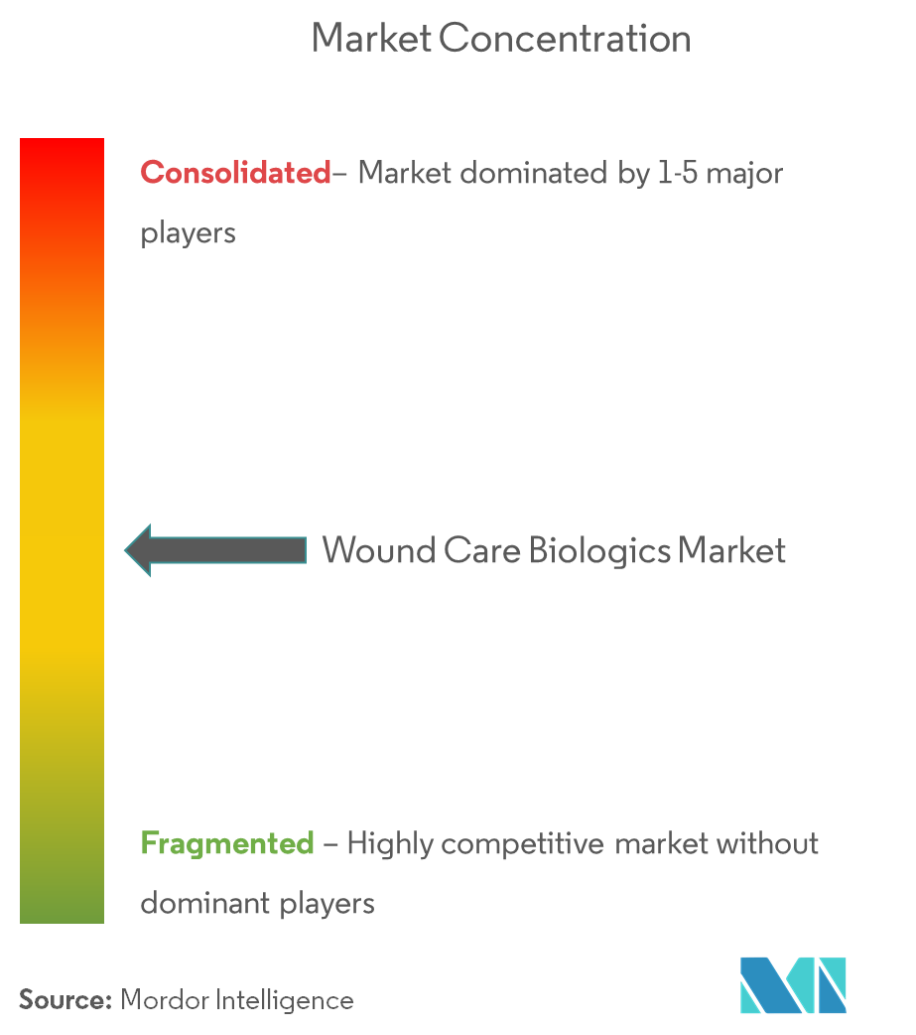
Wound Care Biologics Market News
- In July 2022, Biologics company Tides Medical launched of a new product, Artacent AC, a tri-layer skin graft designed for use in the treatment of complex or difficult-to-treat wounds.
- In May 2022, MIMEDX receives USD 4.6 million awards to evaluate PURION processed Dehydrated Human Amnion Chorion Membrane (DHACM) from the department of defense to advance the treatment of combat casualty wounds and burns.
Wound Care Biologics Market Report - Table of Contents
1. INTRODUCTION
- 1.1 Study Assumptions and Market Definition
- 1.2 Scope of the Study
2. RESEARCH METHODOLOGY
3. EXECUTIVE SUMMARY
4. MARKET DYNAMICS
- 4.1 Market Overview
-
4.2 Market Drivers
- 4.2.1 Growing Burden of Burn Injuries and Road Accidents
- 4.2.2 Government Initiatives Regarding Wound Care Treatment
-
4.3 Market Restraints
- 4.3.1 High Treatment Cost
- 4.3.2 Stringent Regulatory Guidelines and Challenges Faced by the Manufacturers
-
4.4 Porter's Five Forces Analysis
- 4.4.1 Threat of New Entrants
- 4.4.2 Bargaining Power of Buyers/Consumers
- 4.4.3 Bargaining Power of Suppliers
- 4.4.4 Threat of Substitute Products
- 4.4.5 Intensity of Competitive Rivalry
5. MARKET SEGMENTATION (Market Size by Value - USD Million)
-
5.1 By Product
- 5.1.1 Biological Skin Substitutes
- 5.1.2 Topical Agents
-
5.2 By Wound Type
- 5.2.1 Ulcers
- 5.2.1.1 Diabetic Foot Ulcers
- 5.2.1.2 Venous Ulcers
- 5.2.1.3 Pressure Ulcers
- 5.2.1.4 Other Ulcers
- 5.2.2 Surgical and Traumatic Wounds
- 5.2.3 Burns
-
5.3 End User
- 5.3.1 Hospitals/Clinics
- 5.3.2 Ambulatory Surgical Centers
- 5.3.3 Other End Users
-
5.4 Geography
- 5.4.1 North America
- 5.4.1.1 United States
- 5.4.1.2 Canada
- 5.4.1.3 Mexico
- 5.4.2 Europe
- 5.4.2.1 Germany
- 5.4.2.2 United Kingdom
- 5.4.2.3 France
- 5.4.2.4 Italy
- 5.4.2.5 Spain
- 5.4.2.6 Rest of Europe
- 5.4.3 Asia-Pacific
- 5.4.3.1 China
- 5.4.3.2 Japan
- 5.4.3.3 India
- 5.4.3.4 Australia
- 5.4.3.5 South Korea
- 5.4.3.6 Rest of Asia-Pacific
- 5.4.4 Middle-East and Africa
- 5.4.4.1 GCC
- 5.4.4.2 South Africa
- 5.4.4.3 Rest of Middle-East and Africa
- 5.4.5 South America
- 5.4.5.1 Brazil
- 5.4.5.2 Argentina
- 5.4.5.3 Rest of South America
6. COMPETITIVE LANDSCAPE
-
6.1 Company Profiles
- 6.1.1 Integra LifeSciences Corporation (ACell Inc.)
- 6.1.2 Kerecis
- 6.1.3 Marine Polymer Technologies Inc.
- 6.1.4 MiMedx Inc.
- 6.1.5 Bioventus Inc. (MISONIX Inc.)
- 6.1.6 Molnlycke Health Care
- 6.1.7 Smith & Nephew PLC
- 6.1.8 Stryker Inc. (Wright Medical Group NV)
- 6.1.9 MTF Biologics
- 6.1.10 Lynch Biologics, LLC
- 6.1.11 Skye Biologics Holdings, LLC
- *List Not Exhaustive
7. MARKET OPPORTUNITIES AND FUTURE TRENDS
** Subject To AvailablityWound Care Biologics Industry Segmentation
As per the scope of the report, wound care biologics refer to products that are used for controlling and healing infections. Wound healing is a complex process involving inflammation, accumulation of tissue, deposition of collagen, and formation of epithelial cell layers. The Wound Care Biologics Market is Segmented by Product (Biological Skin Substitutes and Topical Agents), Wound Type (Ulcers, Surgical and Traumatic Wounds, and Burns), End-User (Hospitals/Clinics, Ambulatory Surgical Centers, and Other End Users), and Geography (North America, Europe, Asia-Pacific, Middle East & Africa, and South America). The market report also covers the estimated market sizes and trends for 17 different countries across major regions, globally. The report offers the value (in USD million) for the above segments.
| By Product | Biological Skin Substitutes | |
| Topical Agents | ||
| By Wound Type | Ulcers | Diabetic Foot Ulcers |
| Venous Ulcers | ||
| Pressure Ulcers | ||
| Other Ulcers | ||
| By Wound Type | Surgical and Traumatic Wounds | |
| Burns | ||
| End User | Hospitals/Clinics | |
| Ambulatory Surgical Centers | ||
| Other End Users | ||
| Geography | North America | United States |
| Canada | ||
| Mexico | ||
| Geography | Europe | Germany |
| United Kingdom | ||
| France | ||
| Italy | ||
| Spain | ||
| Rest of Europe | ||
| Geography | Asia-Pacific | China |
| Japan | ||
| India | ||
| Australia | ||
| South Korea | ||
| Rest of Asia-Pacific | ||
| Geography | Middle-East and Africa | GCC |
| South Africa | ||
| Rest of Middle-East and Africa | ||
| Geography | South America | Brazil |
| Argentina | ||
| Rest of South America |
Wound Care Biologics Market Research FAQs
What is the current Global Wound Care Biologics Market size?
The Global Wound Care Biologics Market is projected to register a CAGR of 8% during the forecast period (2024-2029)
Who are the key players in Global Wound Care Biologics Market?
Integra LifeSciences Corporation, Mölnlycke Health Care, Smith & Nephew plc, Kerecis and MiMedx Inc. are the major companies operating in the Global Wound Care Biologics Market.
Which is the fastest growing region in Global Wound Care Biologics Market?
Asia-Pacific is estimated to grow at the highest CAGR over the forecast period (2024-2029).
Which region has the biggest share in Global Wound Care Biologics Market?
In 2024, the North America accounts for the largest market share in Global Wound Care Biologics Market.
What years does this Global Wound Care Biologics Market cover?
The report covers the Global Wound Care Biologics Market historical market size for years: 2019, 2020, 2021, 2022 and 2023. The report also forecasts the Global Wound Care Biologics Market size for years: 2024, 2025, 2026, 2027, 2028 and 2029.
What are the regulatory hurdles for bringing new wound biologics to market?
The regulatory hurdles for bringing new wound biologics to market are a) Clinical trial requirements b) Safety and efficacy testing c) Navigating regulatory approvals
Wound Care Biologics Industry Report
The global wound care biologics market is experiencing a strong growth trajectory, fueled by an increase in chronic wounds, surgical interventions, and an aging population with conditions like diabetes that hinder wound healing. The market is primarily segmented into biological skin substitutes and topical agents, with biological skin substitutes leading due to their capability to promote rapid wound healing by facilitating angiogenesis and collagen formation. Ulcers, particularly diabetic foot ulcers and venous leg ulcers, constitute the largest segment by wound type, reflecting the rising diabetic demographic. Hospitals, the main end-users, are increasingly adopting these advanced biologics to manage high patient volumes effectively. Geographically, North America is at the forefront, propelled by technological advancements in healthcare, while the Asia-Pacific region demonstrates swift growth due to enhanced healthcare awareness and infrastructural investments. Technological innovations like 3D printing are set to transform the sector by improving the complexity of bioprinted skin substitutes used primarily for burn victims and extensive grafts. Despite the high cost of biologic products posing challenges, the market outlook remains positive with considerable investments flowing into R&D to develop more patient-centric, efficient wound healing solutions. For further detailed insights and a market forecast outlook, access a free report PDF download from Mordor Intelligence™ Industry Reports.



